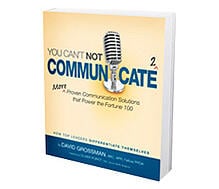You might not yet realize the importance of a Strategic Messaging Methodology, or even know that you need one. Isn’t that always how it is? You don’t know what you’re missing until you find it?
So what is a Strategic Messaging Methodology, and what can it do for you, your leaders, and your organization?
Simply put, it’s a process that helps you think strategically about how you develop your story, drive alignment, and tell it powerfully—whether it’s a large organizational story or whether you want to communicate change inside your organization.
When done well, Strategic Messaging allows you to:
- Define and prioritize the audiences
Let your audience know who will receive the messages and focus on the common ground between them. - Identify where key audiences are coming from
Gather what their information needs are so your messages can influence and drive appropriate action. - Agree on compelling messages
You can agree on and articulate clear, credible, and compelling messages about the topic. Strategic Messaging Methodology is a process that helps you think strategically about how you develop your company's story. - Outline actions expected
Let key audiences know what behaviors and actions are expected of them. - Connect with your audiences
So they know you and what’s important to you. - Deliver your messages with confidence
Because you’re well prepared, you know your messages will hit the mark, and you can re-use your platform time and time again to master your delivery. - Validate the implementation plan
Identify any gaps on a topic before going “prime time.”
A messaging methodology helps you efficiently capture the core messages for any kind of topic—organizational, key initiatives, timely announcements, department plans, even people—in a strategic message platform.
The foundation for all communication relating to a particular topic, your strategic message platform is the blueprint from which you build customized communications to reach your end audience (e.g., employees, clients, customers, etc.) so they’re getting the information in a way that meets their needs.
Examples of communication tools that can be developed using components of a message platform include:
- Management talking points
- Marketing collateral (e.g., brochures)
- Speeches
- Presentations
- Voicemail and Email messages
- Website copy
- Blog copy
- Social media applications
- FAQs
- Press releases
- Direct mail
- Pocket cards
- Intranets
- And more
Do you have a strategic messaging plan in place?
—David Grossman


Comments on this post